Annotated Bibliography: Reinforced Concrete Structures Analysis
VerifiedAdded on 2023/04/11
|11
|1752
|414
Annotated Bibliography
AI Summary
This annotated bibliography examines various aspects of reinforced cement concrete (RCC) construction, drawing from peer-reviewed journals and conference articles. The introduction provides a basic overview of RCC and its components, highlighting the importance of iron rods in providing ...
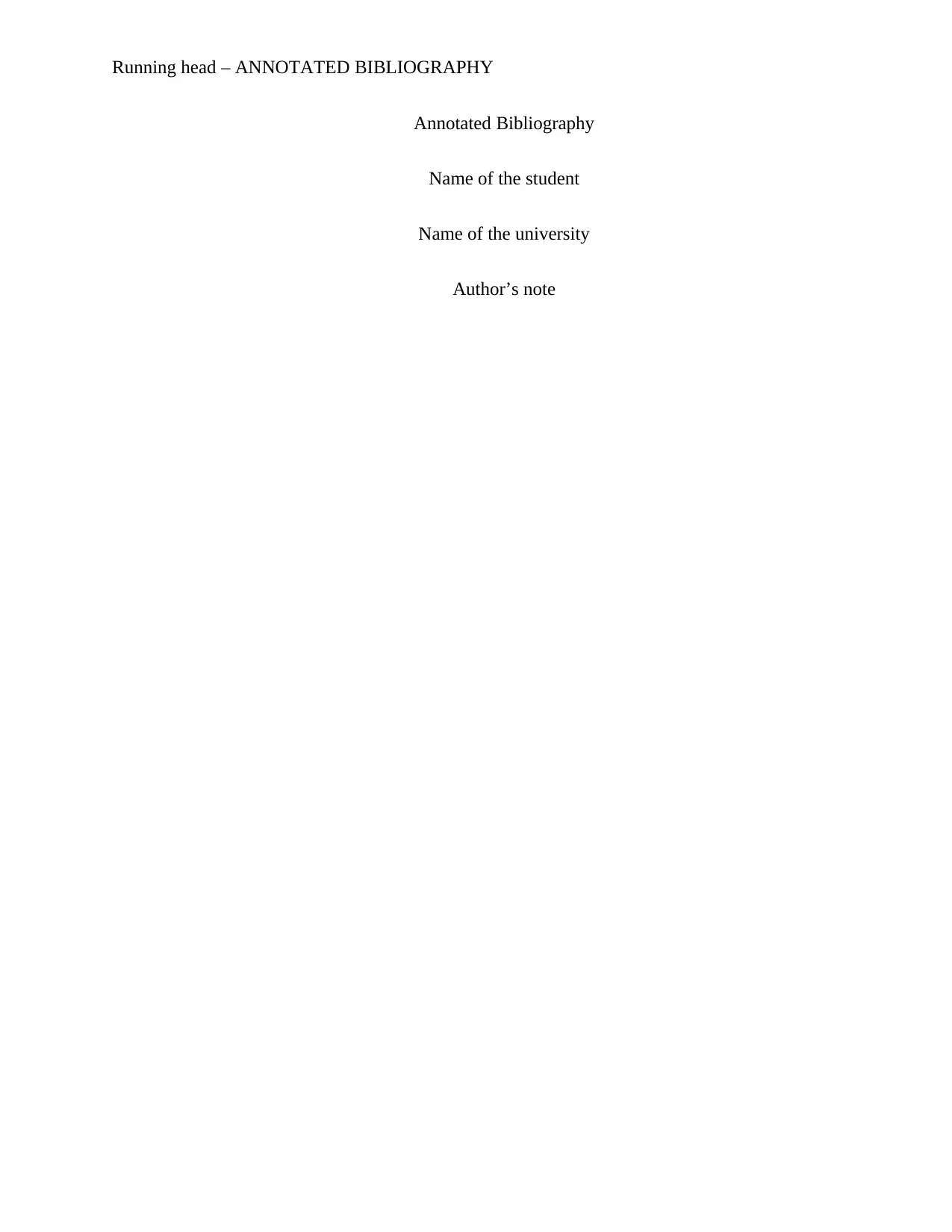
Running head – ANNOTATED BIBLIOGRAPHY
Annotated Bibliography
Name of the student
Name of the university
Author’s note
Annotated Bibliography
Name of the student
Name of the university
Author’s note
Paraphrase This Document
Need a fresh take? Get an instant paraphrase of this document with our AI Paraphraser
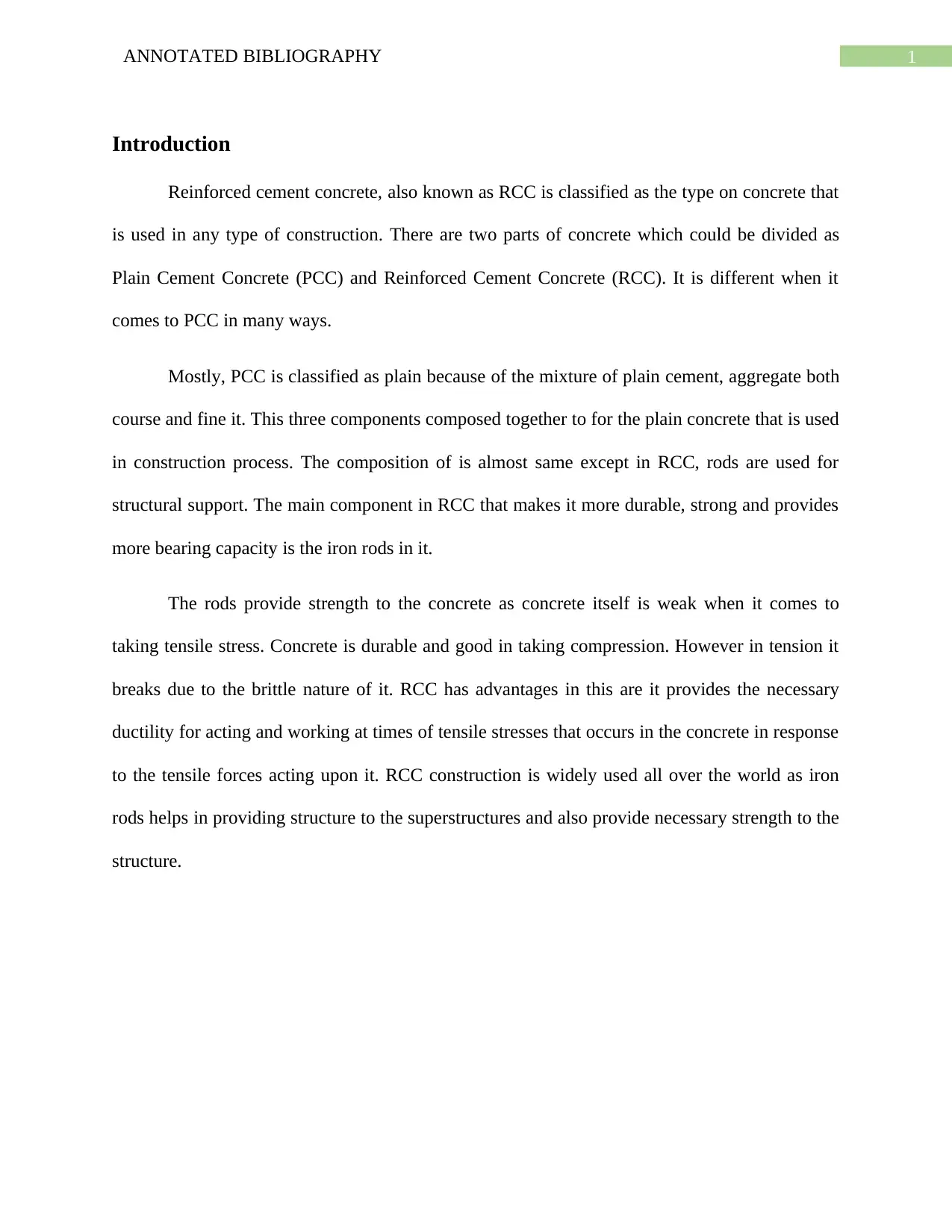
1ANNOTATED BIBLIOGRAPHY
Introduction
Reinforced cement concrete, also known as RCC is classified as the type on concrete that
is used in any type of construction. There are two parts of concrete which could be divided as
Plain Cement Concrete (PCC) and Reinforced Cement Concrete (RCC). It is different when it
comes to PCC in many ways.
Mostly, PCC is classified as plain because of the mixture of plain cement, aggregate both
course and fine it. This three components composed together to for the plain concrete that is used
in construction process. The composition of is almost same except in RCC, rods are used for
structural support. The main component in RCC that makes it more durable, strong and provides
more bearing capacity is the iron rods in it.
The rods provide strength to the concrete as concrete itself is weak when it comes to
taking tensile stress. Concrete is durable and good in taking compression. However in tension it
breaks due to the brittle nature of it. RCC has advantages in this are it provides the necessary
ductility for acting and working at times of tensile stresses that occurs in the concrete in response
to the tensile forces acting upon it. RCC construction is widely used all over the world as iron
rods helps in providing structure to the superstructures and also provide necessary strength to the
structure.
Introduction
Reinforced cement concrete, also known as RCC is classified as the type on concrete that
is used in any type of construction. There are two parts of concrete which could be divided as
Plain Cement Concrete (PCC) and Reinforced Cement Concrete (RCC). It is different when it
comes to PCC in many ways.
Mostly, PCC is classified as plain because of the mixture of plain cement, aggregate both
course and fine it. This three components composed together to for the plain concrete that is used
in construction process. The composition of is almost same except in RCC, rods are used for
structural support. The main component in RCC that makes it more durable, strong and provides
more bearing capacity is the iron rods in it.
The rods provide strength to the concrete as concrete itself is weak when it comes to
taking tensile stress. Concrete is durable and good in taking compression. However in tension it
breaks due to the brittle nature of it. RCC has advantages in this are it provides the necessary
ductility for acting and working at times of tensile stresses that occurs in the concrete in response
to the tensile forces acting upon it. RCC construction is widely used all over the world as iron
rods helps in providing structure to the superstructures and also provide necessary strength to the
structure.

2ANNOTATED BIBLIOGRAPHY
[1]A. Wibowo, J. Wilson, N. Lam and E. Gad, "Yield Penetration Displacement of
Lightly Reinforced Concrete Columns", Applied Mechanics and Materials, vol. 845,
pp. 119-125, 2016. Available: 10.4028/www.scientific.net/amm.845.119.
The aim of the journal is to discuss about the reinforced cement concrete design and its
penetration due to yield or the deformation of the columns due to slip. The yielding penetration
or the slip deformation is defined as the rotation of some rigid body or the rotation of columns in
a superstructure. It occurs due to the formation of an opening gap at the end of the extension of
the column to its very foundations. The interface that occurs due the penetrations of an inelastic
form of strain in the reinforcement of tensile stresses that is embedded at the end of the columns’
extension which is the foundation.
[2]T. Pham and H. Hao, "Behavior of fiber-reinforced polymer-strengthened
reinforced concrete beams under static and impact loads", International Journal of
Protective Structures, vol. 8, no. 1, pp. 3-24, 2016. Available:
10.1177/2041419616658730 [Accessed 22 March 2019].
The journal aims to discuss mostly about the behaviors of the reinforced beams under the
impact of static load and under impact loads at times when fiber based polymers are used as the
reinforcement in the place of iron rods. Studies were conducted to analyze the behavior of the
beams that are made with by fiber polymer as reinforcement under the influence of loads. The
methodology used in the study to find the results were carried out through experiments that have
been conducted o six beams that were test under static load and seven beams under the influence
of impact load
[1]A. Wibowo, J. Wilson, N. Lam and E. Gad, "Yield Penetration Displacement of
Lightly Reinforced Concrete Columns", Applied Mechanics and Materials, vol. 845,
pp. 119-125, 2016. Available: 10.4028/www.scientific.net/amm.845.119.
The aim of the journal is to discuss about the reinforced cement concrete design and its
penetration due to yield or the deformation of the columns due to slip. The yielding penetration
or the slip deformation is defined as the rotation of some rigid body or the rotation of columns in
a superstructure. It occurs due to the formation of an opening gap at the end of the extension of
the column to its very foundations. The interface that occurs due the penetrations of an inelastic
form of strain in the reinforcement of tensile stresses that is embedded at the end of the columns’
extension which is the foundation.
[2]T. Pham and H. Hao, "Behavior of fiber-reinforced polymer-strengthened
reinforced concrete beams under static and impact loads", International Journal of
Protective Structures, vol. 8, no. 1, pp. 3-24, 2016. Available:
10.1177/2041419616658730 [Accessed 22 March 2019].
The journal aims to discuss mostly about the behaviors of the reinforced beams under the
impact of static load and under impact loads at times when fiber based polymers are used as the
reinforcement in the place of iron rods. Studies were conducted to analyze the behavior of the
beams that are made with by fiber polymer as reinforcement under the influence of loads. The
methodology used in the study to find the results were carried out through experiments that have
been conducted o six beams that were test under static load and seven beams under the influence
of impact load
⊘ This is a preview!⊘
Do you want full access?
Subscribe today to unlock all pages.

Trusted by 1+ million students worldwide
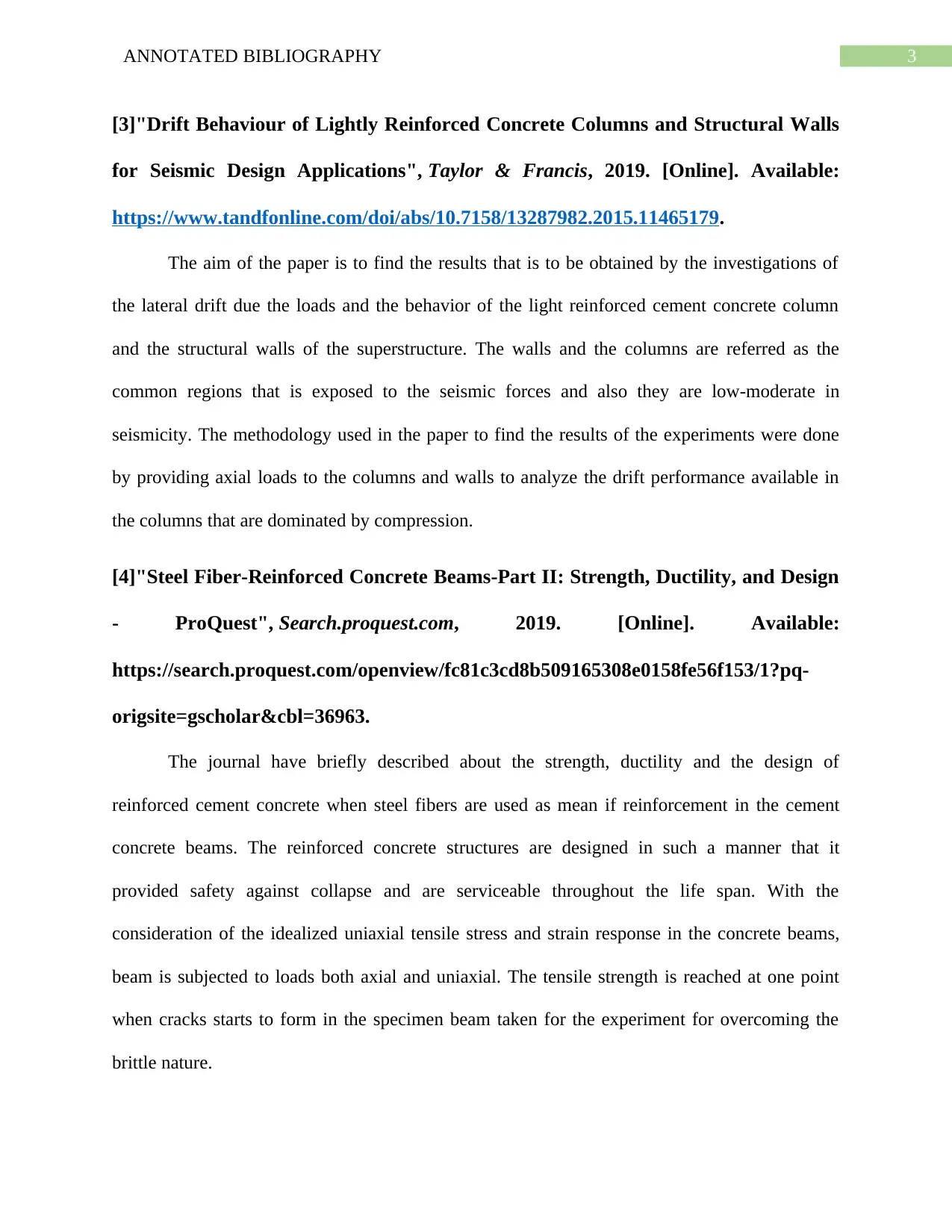
3ANNOTATED BIBLIOGRAPHY
[3]"Drift Behaviour of Lightly Reinforced Concrete Columns and Structural Walls
for Seismic Design Applications", Taylor & Francis, 2019. [Online]. Available:
https://www.tandfonline.com/doi/abs/10.7158/13287982.2015.11465179.
The aim of the paper is to find the results that is to be obtained by the investigations of
the lateral drift due the loads and the behavior of the light reinforced cement concrete column
and the structural walls of the superstructure. The walls and the columns are referred as the
common regions that is exposed to the seismic forces and also they are low-moderate in
seismicity. The methodology used in the paper to find the results of the experiments were done
by providing axial loads to the columns and walls to analyze the drift performance available in
the columns that are dominated by compression.
[4]"Steel Fiber-Reinforced Concrete Beams-Part II: Strength, Ductility, and Design
- ProQuest", Search.proquest.com, 2019. [Online]. Available:
https://search.proquest.com/openview/fc81c3cd8b509165308e0158fe56f153/1?pq-
origsite=gscholar&cbl=36963.
The journal have briefly described about the strength, ductility and the design of
reinforced cement concrete when steel fibers are used as mean if reinforcement in the cement
concrete beams. The reinforced concrete structures are designed in such a manner that it
provided safety against collapse and are serviceable throughout the life span. With the
consideration of the idealized uniaxial tensile stress and strain response in the concrete beams,
beam is subjected to loads both axial and uniaxial. The tensile strength is reached at one point
when cracks starts to form in the specimen beam taken for the experiment for overcoming the
brittle nature.
[3]"Drift Behaviour of Lightly Reinforced Concrete Columns and Structural Walls
for Seismic Design Applications", Taylor & Francis, 2019. [Online]. Available:
https://www.tandfonline.com/doi/abs/10.7158/13287982.2015.11465179.
The aim of the paper is to find the results that is to be obtained by the investigations of
the lateral drift due the loads and the behavior of the light reinforced cement concrete column
and the structural walls of the superstructure. The walls and the columns are referred as the
common regions that is exposed to the seismic forces and also they are low-moderate in
seismicity. The methodology used in the paper to find the results of the experiments were done
by providing axial loads to the columns and walls to analyze the drift performance available in
the columns that are dominated by compression.
[4]"Steel Fiber-Reinforced Concrete Beams-Part II: Strength, Ductility, and Design
- ProQuest", Search.proquest.com, 2019. [Online]. Available:
https://search.proquest.com/openview/fc81c3cd8b509165308e0158fe56f153/1?pq-
origsite=gscholar&cbl=36963.
The journal have briefly described about the strength, ductility and the design of
reinforced cement concrete when steel fibers are used as mean if reinforcement in the cement
concrete beams. The reinforced concrete structures are designed in such a manner that it
provided safety against collapse and are serviceable throughout the life span. With the
consideration of the idealized uniaxial tensile stress and strain response in the concrete beams,
beam is subjected to loads both axial and uniaxial. The tensile strength is reached at one point
when cracks starts to form in the specimen beam taken for the experiment for overcoming the
brittle nature.
Paraphrase This Document
Need a fresh take? Get an instant paraphrase of this document with our AI Paraphraser

4ANNOTATED BIBLIOGRAPHY
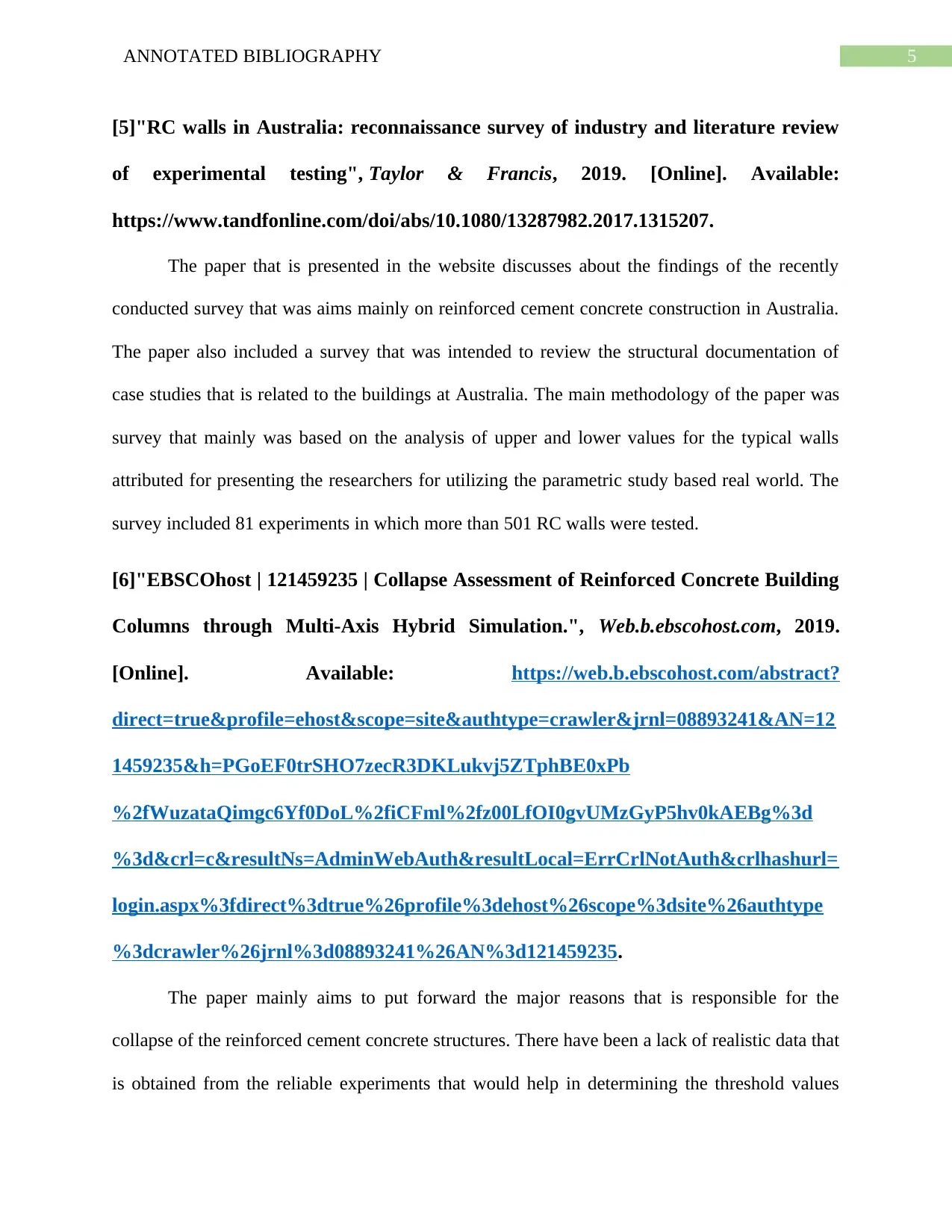
5ANNOTATED BIBLIOGRAPHY
[5]"RC walls in Australia: reconnaissance survey of industry and literature review
of experimental testing", Taylor & Francis, 2019. [Online]. Available:
https://www.tandfonline.com/doi/abs/10.1080/13287982.2017.1315207.
The paper that is presented in the website discusses about the findings of the recently
conducted survey that was aims mainly on reinforced cement concrete construction in Australia.
The paper also included a survey that was intended to review the structural documentation of
case studies that is related to the buildings at Australia. The main methodology of the paper was
survey that mainly was based on the analysis of upper and lower values for the typical walls
attributed for presenting the researchers for utilizing the parametric study based real world. The
survey included 81 experiments in which more than 501 RC walls were tested.
[6]"EBSCOhost | 121459235 | Collapse Assessment of Reinforced Concrete Building
Columns through Multi-Axis Hybrid Simulation.", Web.b.ebscohost.com, 2019.
[Online]. Available: https://web.b.ebscohost.com/abstract?
direct=true&profile=ehost&scope=site&authtype=crawler&jrnl=08893241&AN=12
1459235&h=PGoEF0trSHO7zecR3DKLukvj5ZTphBE0xPb
%2fWuzataQimgc6Yf0DoL%2fiCFml%2fz00LfOI0gvUMzGyP5hv0kAEBg%3d
%3d&crl=c&resultNs=AdminWebAuth&resultLocal=ErrCrlNotAuth&crlhashurl=
login.aspx%3fdirect%3dtrue%26profile%3dehost%26scope%3dsite%26authtype
%3dcrawler%26jrnl%3d08893241%26AN%3d121459235.
The paper mainly aims to put forward the major reasons that is responsible for the
collapse of the reinforced cement concrete structures. There have been a lack of realistic data that
is obtained from the reliable experiments that would help in determining the threshold values
[5]"RC walls in Australia: reconnaissance survey of industry and literature review
of experimental testing", Taylor & Francis, 2019. [Online]. Available:
https://www.tandfonline.com/doi/abs/10.1080/13287982.2017.1315207.
The paper that is presented in the website discusses about the findings of the recently
conducted survey that was aims mainly on reinforced cement concrete construction in Australia.
The paper also included a survey that was intended to review the structural documentation of
case studies that is related to the buildings at Australia. The main methodology of the paper was
survey that mainly was based on the analysis of upper and lower values for the typical walls
attributed for presenting the researchers for utilizing the parametric study based real world. The
survey included 81 experiments in which more than 501 RC walls were tested.
[6]"EBSCOhost | 121459235 | Collapse Assessment of Reinforced Concrete Building
Columns through Multi-Axis Hybrid Simulation.", Web.b.ebscohost.com, 2019.
[Online]. Available: https://web.b.ebscohost.com/abstract?
direct=true&profile=ehost&scope=site&authtype=crawler&jrnl=08893241&AN=12
1459235&h=PGoEF0trSHO7zecR3DKLukvj5ZTphBE0xPb
%2fWuzataQimgc6Yf0DoL%2fiCFml%2fz00LfOI0gvUMzGyP5hv0kAEBg%3d
%3d&crl=c&resultNs=AdminWebAuth&resultLocal=ErrCrlNotAuth&crlhashurl=
login.aspx%3fdirect%3dtrue%26profile%3dehost%26scope%3dsite%26authtype
%3dcrawler%26jrnl%3d08893241%26AN%3d121459235.
The paper mainly aims to put forward the major reasons that is responsible for the
collapse of the reinforced cement concrete structures. There have been a lack of realistic data that
is obtained from the reliable experiments that would help in determining the threshold values
⊘ This is a preview!⊘
Do you want full access?
Subscribe today to unlock all pages.

Trusted by 1+ million students worldwide
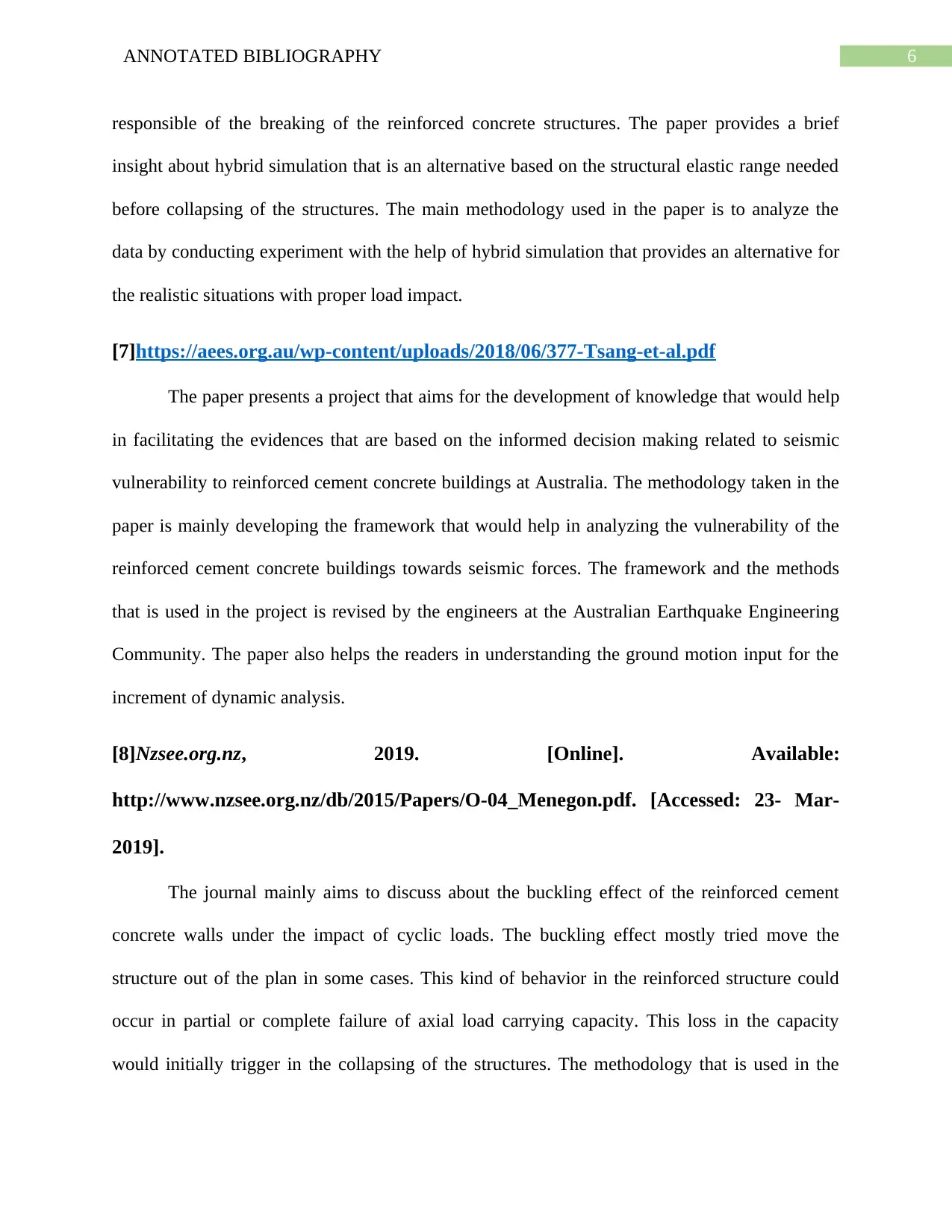
6ANNOTATED BIBLIOGRAPHY
responsible of the breaking of the reinforced concrete structures. The paper provides a brief
insight about hybrid simulation that is an alternative based on the structural elastic range needed
before collapsing of the structures. The main methodology used in the paper is to analyze the
data by conducting experiment with the help of hybrid simulation that provides an alternative for
the realistic situations with proper load impact.
[7]https://aees.org.au/wp-content/uploads/2018/06/377-Tsang-et-al.pdf
The paper presents a project that aims for the development of knowledge that would help
in facilitating the evidences that are based on the informed decision making related to seismic
vulnerability to reinforced cement concrete buildings at Australia. The methodology taken in the
paper is mainly developing the framework that would help in analyzing the vulnerability of the
reinforced cement concrete buildings towards seismic forces. The framework and the methods
that is used in the project is revised by the engineers at the Australian Earthquake Engineering
Community. The paper also helps the readers in understanding the ground motion input for the
increment of dynamic analysis.
[8]Nzsee.org.nz, 2019. [Online]. Available:
http://www.nzsee.org.nz/db/2015/Papers/O-04_Menegon.pdf. [Accessed: 23- Mar-
2019].
The journal mainly aims to discuss about the buckling effect of the reinforced cement
concrete walls under the impact of cyclic loads. The buckling effect mostly tried move the
structure out of the plan in some cases. This kind of behavior in the reinforced structure could
occur in partial or complete failure of axial load carrying capacity. This loss in the capacity
would initially trigger in the collapsing of the structures. The methodology that is used in the
responsible of the breaking of the reinforced concrete structures. The paper provides a brief
insight about hybrid simulation that is an alternative based on the structural elastic range needed
before collapsing of the structures. The main methodology used in the paper is to analyze the
data by conducting experiment with the help of hybrid simulation that provides an alternative for
the realistic situations with proper load impact.
[7]https://aees.org.au/wp-content/uploads/2018/06/377-Tsang-et-al.pdf
The paper presents a project that aims for the development of knowledge that would help
in facilitating the evidences that are based on the informed decision making related to seismic
vulnerability to reinforced cement concrete buildings at Australia. The methodology taken in the
paper is mainly developing the framework that would help in analyzing the vulnerability of the
reinforced cement concrete buildings towards seismic forces. The framework and the methods
that is used in the project is revised by the engineers at the Australian Earthquake Engineering
Community. The paper also helps the readers in understanding the ground motion input for the
increment of dynamic analysis.
[8]Nzsee.org.nz, 2019. [Online]. Available:
http://www.nzsee.org.nz/db/2015/Papers/O-04_Menegon.pdf. [Accessed: 23- Mar-
2019].
The journal mainly aims to discuss about the buckling effect of the reinforced cement
concrete walls under the impact of cyclic loads. The buckling effect mostly tried move the
structure out of the plan in some cases. This kind of behavior in the reinforced structure could
occur in partial or complete failure of axial load carrying capacity. This loss in the capacity
would initially trigger in the collapsing of the structures. The methodology that is used in the
Paraphrase This Document
Need a fresh take? Get an instant paraphrase of this document with our AI Paraphraser
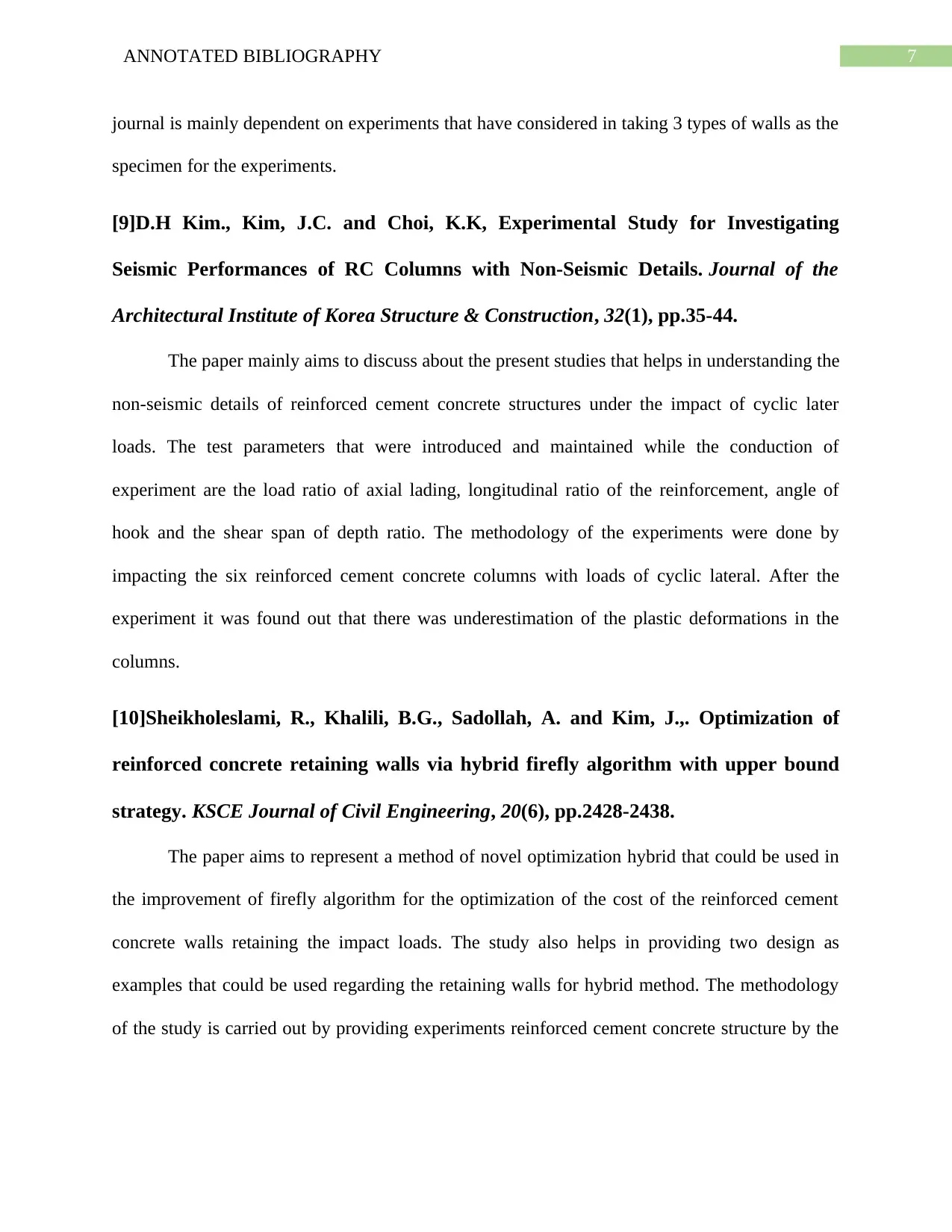
7ANNOTATED BIBLIOGRAPHY
journal is mainly dependent on experiments that have considered in taking 3 types of walls as the
specimen for the experiments.
[9]D.H Kim., Kim, J.C. and Choi, K.K, Experimental Study for Investigating
Seismic Performances of RC Columns with Non-Seismic Details. Journal of the
Architectural Institute of Korea Structure & Construction, 32(1), pp.35-44.
The paper mainly aims to discuss about the present studies that helps in understanding the
non-seismic details of reinforced cement concrete structures under the impact of cyclic later
loads. The test parameters that were introduced and maintained while the conduction of
experiment are the load ratio of axial lading, longitudinal ratio of the reinforcement, angle of
hook and the shear span of depth ratio. The methodology of the experiments were done by
impacting the six reinforced cement concrete columns with loads of cyclic lateral. After the
experiment it was found out that there was underestimation of the plastic deformations in the
columns.
[10]Sheikholeslami, R., Khalili, B.G., Sadollah, A. and Kim, J.,. Optimization of
reinforced concrete retaining walls via hybrid firefly algorithm with upper bound
strategy. KSCE Journal of Civil Engineering, 20(6), pp.2428-2438.
The paper aims to represent a method of novel optimization hybrid that could be used in
the improvement of firefly algorithm for the optimization of the cost of the reinforced cement
concrete walls retaining the impact loads. The study also helps in providing two design as
examples that could be used regarding the retaining walls for hybrid method. The methodology
of the study is carried out by providing experiments reinforced cement concrete structure by the
journal is mainly dependent on experiments that have considered in taking 3 types of walls as the
specimen for the experiments.
[9]D.H Kim., Kim, J.C. and Choi, K.K, Experimental Study for Investigating
Seismic Performances of RC Columns with Non-Seismic Details. Journal of the
Architectural Institute of Korea Structure & Construction, 32(1), pp.35-44.
The paper mainly aims to discuss about the present studies that helps in understanding the
non-seismic details of reinforced cement concrete structures under the impact of cyclic later
loads. The test parameters that were introduced and maintained while the conduction of
experiment are the load ratio of axial lading, longitudinal ratio of the reinforcement, angle of
hook and the shear span of depth ratio. The methodology of the experiments were done by
impacting the six reinforced cement concrete columns with loads of cyclic lateral. After the
experiment it was found out that there was underestimation of the plastic deformations in the
columns.
[10]Sheikholeslami, R., Khalili, B.G., Sadollah, A. and Kim, J.,. Optimization of
reinforced concrete retaining walls via hybrid firefly algorithm with upper bound
strategy. KSCE Journal of Civil Engineering, 20(6), pp.2428-2438.
The paper aims to represent a method of novel optimization hybrid that could be used in
the improvement of firefly algorithm for the optimization of the cost of the reinforced cement
concrete walls retaining the impact loads. The study also helps in providing two design as
examples that could be used regarding the retaining walls for hybrid method. The methodology
of the study is carried out by providing experiments reinforced cement concrete structure by the

8ANNOTATED BIBLIOGRAPHY
application of the hybrid algorithm. The paper also provides the limitation of the study by setting
a upper bound strategy that helps in reducing the total structural analysis.
application of the hybrid algorithm. The paper also provides the limitation of the study by setting
a upper bound strategy that helps in reducing the total structural analysis.
⊘ This is a preview!⊘
Do you want full access?
Subscribe today to unlock all pages.

Trusted by 1+ million students worldwide
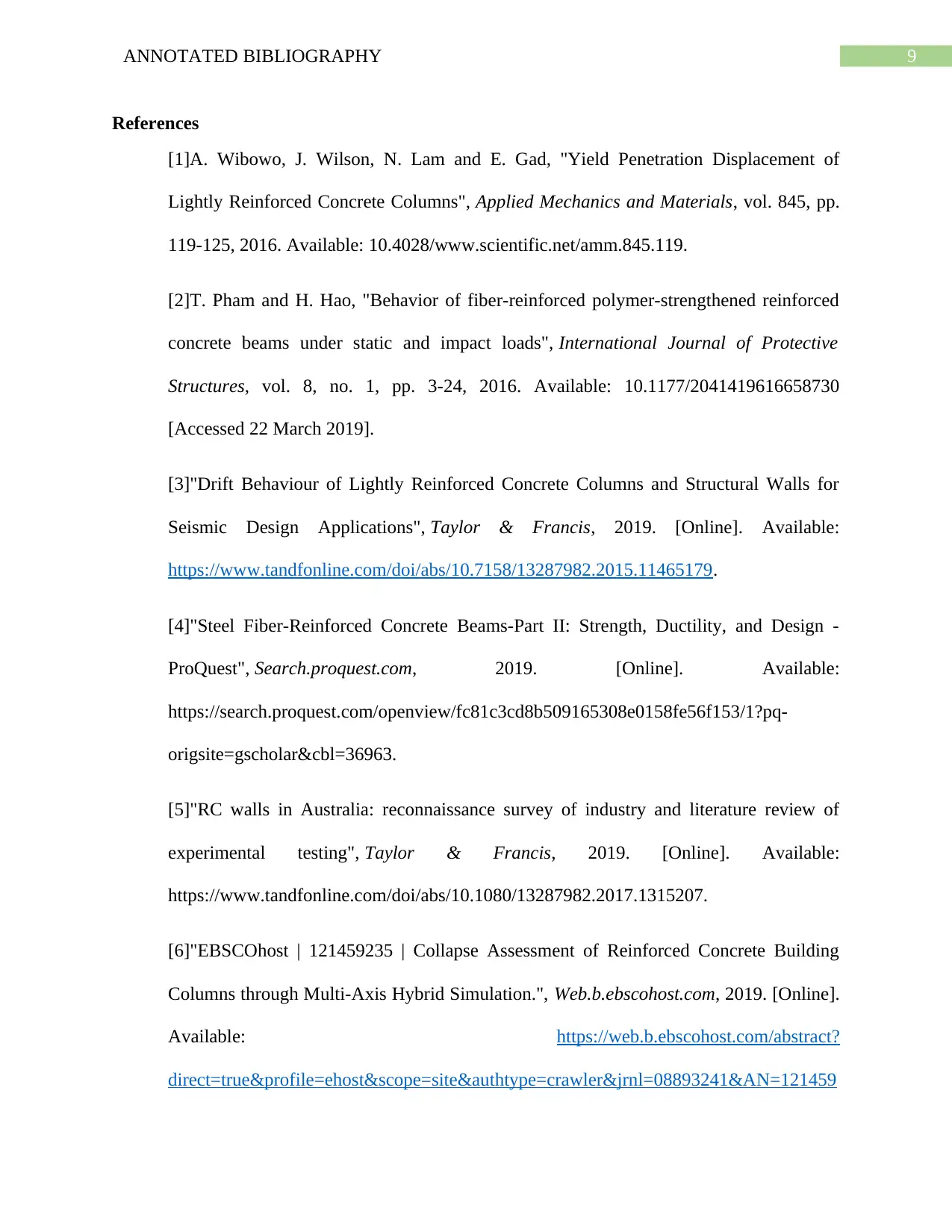
9ANNOTATED BIBLIOGRAPHY
References
[1]A. Wibowo, J. Wilson, N. Lam and E. Gad, "Yield Penetration Displacement of
Lightly Reinforced Concrete Columns", Applied Mechanics and Materials, vol. 845, pp.
119-125, 2016. Available: 10.4028/www.scientific.net/amm.845.119.
[2]T. Pham and H. Hao, "Behavior of fiber-reinforced polymer-strengthened reinforced
concrete beams under static and impact loads", International Journal of Protective
Structures, vol. 8, no. 1, pp. 3-24, 2016. Available: 10.1177/2041419616658730
[Accessed 22 March 2019].
[3]"Drift Behaviour of Lightly Reinforced Concrete Columns and Structural Walls for
Seismic Design Applications", Taylor & Francis, 2019. [Online]. Available:
https://www.tandfonline.com/doi/abs/10.7158/13287982.2015.11465179.
[4]"Steel Fiber-Reinforced Concrete Beams-Part II: Strength, Ductility, and Design -
ProQuest", Search.proquest.com, 2019. [Online]. Available:
https://search.proquest.com/openview/fc81c3cd8b509165308e0158fe56f153/1?pq-
origsite=gscholar&cbl=36963.
[5]"RC walls in Australia: reconnaissance survey of industry and literature review of
experimental testing", Taylor & Francis, 2019. [Online]. Available:
https://www.tandfonline.com/doi/abs/10.1080/13287982.2017.1315207.
[6]"EBSCOhost | 121459235 | Collapse Assessment of Reinforced Concrete Building
Columns through Multi-Axis Hybrid Simulation.", Web.b.ebscohost.com, 2019. [Online].
Available: https://web.b.ebscohost.com/abstract?
direct=true&profile=ehost&scope=site&authtype=crawler&jrnl=08893241&AN=121459
References
[1]A. Wibowo, J. Wilson, N. Lam and E. Gad, "Yield Penetration Displacement of
Lightly Reinforced Concrete Columns", Applied Mechanics and Materials, vol. 845, pp.
119-125, 2016. Available: 10.4028/www.scientific.net/amm.845.119.
[2]T. Pham and H. Hao, "Behavior of fiber-reinforced polymer-strengthened reinforced
concrete beams under static and impact loads", International Journal of Protective
Structures, vol. 8, no. 1, pp. 3-24, 2016. Available: 10.1177/2041419616658730
[Accessed 22 March 2019].
[3]"Drift Behaviour of Lightly Reinforced Concrete Columns and Structural Walls for
Seismic Design Applications", Taylor & Francis, 2019. [Online]. Available:
https://www.tandfonline.com/doi/abs/10.7158/13287982.2015.11465179.
[4]"Steel Fiber-Reinforced Concrete Beams-Part II: Strength, Ductility, and Design -
ProQuest", Search.proquest.com, 2019. [Online]. Available:
https://search.proquest.com/openview/fc81c3cd8b509165308e0158fe56f153/1?pq-
origsite=gscholar&cbl=36963.
[5]"RC walls in Australia: reconnaissance survey of industry and literature review of
experimental testing", Taylor & Francis, 2019. [Online]. Available:
https://www.tandfonline.com/doi/abs/10.1080/13287982.2017.1315207.
[6]"EBSCOhost | 121459235 | Collapse Assessment of Reinforced Concrete Building
Columns through Multi-Axis Hybrid Simulation.", Web.b.ebscohost.com, 2019. [Online].
Available: https://web.b.ebscohost.com/abstract?
direct=true&profile=ehost&scope=site&authtype=crawler&jrnl=08893241&AN=121459
Paraphrase This Document
Need a fresh take? Get an instant paraphrase of this document with our AI Paraphraser
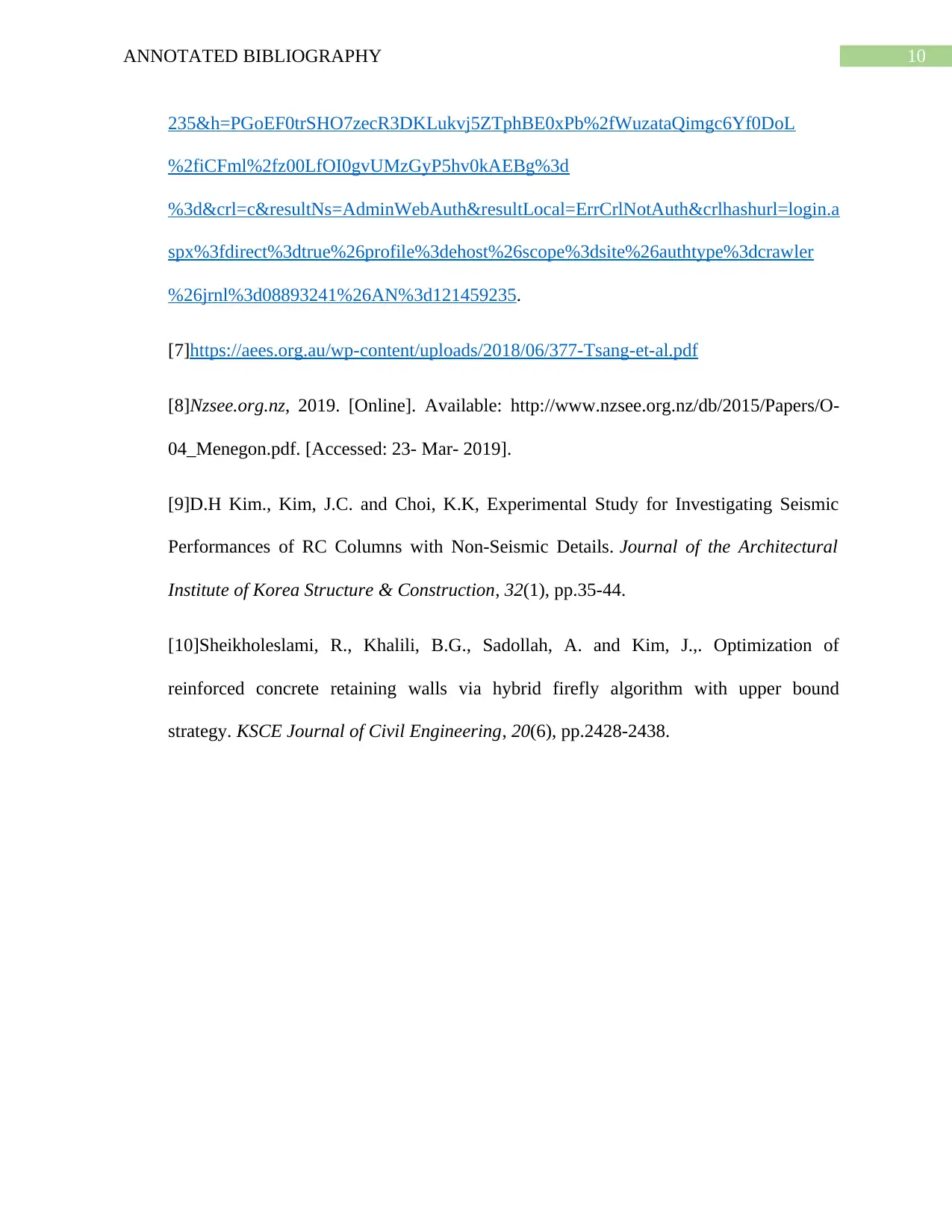
10ANNOTATED BIBLIOGRAPHY
235&h=PGoEF0trSHO7zecR3DKLukvj5ZTphBE0xPb%2fWuzataQimgc6Yf0DoL
%2fiCFml%2fz00LfOI0gvUMzGyP5hv0kAEBg%3d
%3d&crl=c&resultNs=AdminWebAuth&resultLocal=ErrCrlNotAuth&crlhashurl=login.a
spx%3fdirect%3dtrue%26profile%3dehost%26scope%3dsite%26authtype%3dcrawler
%26jrnl%3d08893241%26AN%3d121459235.
[7]https://aees.org.au/wp-content/uploads/2018/06/377-Tsang-et-al.pdf
[8]Nzsee.org.nz, 2019. [Online]. Available: http://www.nzsee.org.nz/db/2015/Papers/O-
04_Menegon.pdf. [Accessed: 23- Mar- 2019].
[9]D.H Kim., Kim, J.C. and Choi, K.K, Experimental Study for Investigating Seismic
Performances of RC Columns with Non-Seismic Details. Journal of the Architectural
Institute of Korea Structure & Construction, 32(1), pp.35-44.
[10]Sheikholeslami, R., Khalili, B.G., Sadollah, A. and Kim, J.,. Optimization of
reinforced concrete retaining walls via hybrid firefly algorithm with upper bound
strategy. KSCE Journal of Civil Engineering, 20(6), pp.2428-2438.
235&h=PGoEF0trSHO7zecR3DKLukvj5ZTphBE0xPb%2fWuzataQimgc6Yf0DoL
%2fiCFml%2fz00LfOI0gvUMzGyP5hv0kAEBg%3d
%3d&crl=c&resultNs=AdminWebAuth&resultLocal=ErrCrlNotAuth&crlhashurl=login.a
spx%3fdirect%3dtrue%26profile%3dehost%26scope%3dsite%26authtype%3dcrawler
%26jrnl%3d08893241%26AN%3d121459235.
[7]https://aees.org.au/wp-content/uploads/2018/06/377-Tsang-et-al.pdf
[8]Nzsee.org.nz, 2019. [Online]. Available: http://www.nzsee.org.nz/db/2015/Papers/O-
04_Menegon.pdf. [Accessed: 23- Mar- 2019].
[9]D.H Kim., Kim, J.C. and Choi, K.K, Experimental Study for Investigating Seismic
Performances of RC Columns with Non-Seismic Details. Journal of the Architectural
Institute of Korea Structure & Construction, 32(1), pp.35-44.
[10]Sheikholeslami, R., Khalili, B.G., Sadollah, A. and Kim, J.,. Optimization of
reinforced concrete retaining walls via hybrid firefly algorithm with upper bound
strategy. KSCE Journal of Civil Engineering, 20(6), pp.2428-2438.
1 out of 11
Your All-in-One AI-Powered Toolkit for Academic Success.
+13062052269
info@desklib.com
Available 24*7 on WhatsApp / Email
![[object Object]](/_next/static/media/star-bottom.7253800d.svg)
Unlock your academic potential
© 2024 | Zucol Services PVT LTD | All rights reserved.